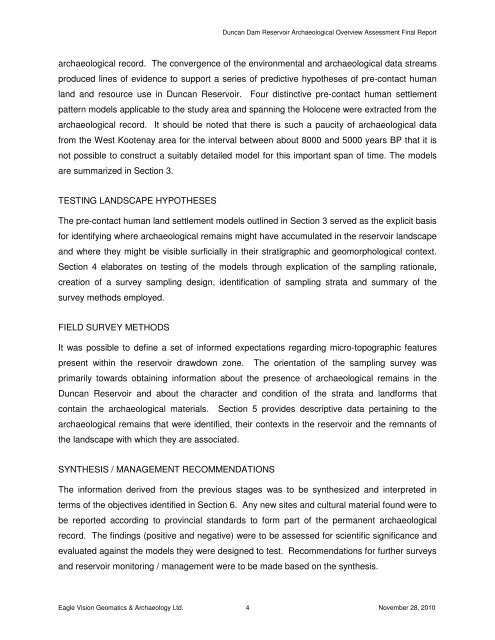November 2010 - BC Hydro
November 2010 - BC Hydro
November 2010 - BC Hydro
Create successful ePaper yourself
Turn your PDF publications into a flip-book with our unique Google optimized e-Paper software.
Duncan Dam Reservoir Archaeological Overview Assessment Final Report<br />
archaeological record. The convergence of the environmental and archaeological data streams<br />
produced lines of evidence to support a series of predictive hypotheses of pre-contact human<br />
land and resource use in Duncan Reservoir. Four distinctive pre-contact human settlement<br />
pattern models applicable to the study area and spanning the Holocene were extracted from the<br />
archaeological record. It should be noted that there is such a paucity of archaeological data<br />
from the West Kootenay area for the interval between about 8000 and 5000 years BP that it is<br />
not possible to construct a suitably detailed model for this important span of time. The models<br />
are summarized in Section 3.<br />
TESTING LANDSCAPE HYPOTHESES<br />
The pre-contact human land settlement models outlined in Section 3 served as the explicit basis<br />
for identifying where archaeological remains might have accumulated in the reservoir landscape<br />
and where they might be visible surficially in their stratigraphic and geomorphological context.<br />
Section 4 elaborates on testing of the models through explication of the sampling rationale,<br />
creation of a survey sampling design, identification of sampling strata and summary of the<br />
survey methods employed.<br />
FIELD SURVEY METHODS<br />
It was possible to define a set of informed expectations regarding micro-topographic features<br />
present within the reservoir drawdown zone. The orientation of the sampling survey was<br />
primarily towards obtaining information about the presence of archaeological remains in the<br />
Duncan Reservoir and about the character and condition of the strata and landforms that<br />
contain the archaeological materials. Section 5 provides descriptive data pertaining to the<br />
archaeological remains that were identified, their contexts in the reservoir and the remnants of<br />
the landscape with which they are associated.<br />
SYNTHESIS / MANAGEMENT RECOMMENDATIONS<br />
The information derived from the previous stages was to be synthesized and interpreted in<br />
terms of the objectives identified in Section 6. Any new sites and cultural material found were to<br />
be reported according to provincial standards to form part of the permanent archaeological<br />
record. The findings (positive and negative) were to be assessed for scientific significance and<br />
evaluated against the models they were designed to test. Recommendations for further surveys<br />
and reservoir monitoring / management were to be made based on the synthesis.<br />
Eagle Vision Geomatics & Archaeology Ltd. 4 <strong>November</strong> 28, <strong>2010</strong>

















